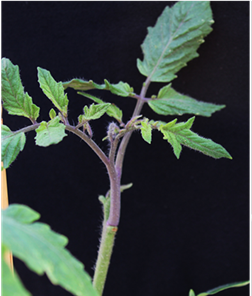Gainsville, Florida, USA
May 19, 2022
New research led by a University of Florida scientist shows a development regulator can help plants grow. In the bigger picture, the study’s results also may help genome editing and as a result, plant breeding.
Development regulators are genes that regulate plant development and growth. UF/IFAS scientists have discovered that one such gene can help deliver DNA into a plant to promote shoot growth form either a stem of a whole plant or young leaves cultured in a petri dish.

Shown here is a red tomato shoot grown from a green stem of tomato plants. Alfred Huo, an assistant professor of horticultural sciences at the UF/IFAS Mid-Florida Research and Education Center, led a new study that shows a way to use plant development regulators to get DNA into tissued plant cultures. Photo courtesy, Alfred Huo, UF/IFAS.
Results from the study show that injection of a plant developmental regulator known as PLT5 into the stem helps some snapdragon and tomatoes grow into new shoots. In addition, scientists found that the PLT5 can help young leaves or petioles of cabbages grow into a whole plant after culturing them in the petri dish.
“Generally, it is extremely difficult for cells from some plants to grow into whole plants from a tissue culture,” said Alfred Huo, an assistant professor of horticultural sciences at the UF/IFAS Mid-Florida Research and Education Center. “By applying PLT5, scientists can more effectively deliver genes or DNA fragments into plant cells, which means plants can grow from the cellular level to adulthood more efficiently.”
This research can help scientists address some questions in basic plant breeding, including how to get certain genes into plants, Huo said. It can also help scientists as they apply genome editing to many plant species.
“This finding can accelerate a breeding program,” Huo said. “You want to use genome editing for plant breeding. But you need to deliver a genome editing toolbox into plants to make the editing happen. With this process, scientists can eventually create some desirable traits in plants and develop new cultivars. In this case, the PLT5 regulator can help deliver this toolbox and help grow young leaves or stems into new plants carrying these desirable traits.”
More than 20 scientists across Florida – including Huo – are part of the UF/IFAS Plant Breeding team. They develop new varieties of citrus, tomatoes, strawberries, blueberries, cattle forages, peanuts, sugarcane, ornamental plants and more.